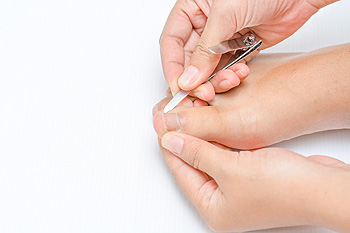February 2023
What Is Ledderhose Disease?

Hard lumps that form on the soles of the feet may be indicative of Ledderhose disease. Ledderhose disease is considered to be a rare foot condition that affects the plantar fascia. The plantar fascia is the band of tissue connecting the heels to the toes and may cause pain while walking. The lumps that form are generally benign and typically affect people middle-aged and older. The ankle joints may be uncomfortable, and a tingling sensation may be felt. The exact reason this foot condition develops is unknown, however, people with certain medical ailments may be prone to Ledderhose disease. These can include diabetic patients, people who consume excess alcohol, and those who take specific medications. Wearing custom-made orthotics may help to relieve pressure on the bottom of the feet. If you have pain in the sole of your foot, it is suggested that you consult with a podiatrist who can diagnose Ledderhose disease and offer the correct treatment options.
Some foot conditions may require additional professional care. If you have any concerns, contact one of our podiatrists of Piedmont Podiatry Associates. Our doctors can provide the care you need to keep you pain-free and on your feet.
Rare Foot Conditions
The majority of foot conditions are common and can be treated by a podiatrist. Standard diagnostic procedures are generally used to identify specific conditions and treatment can be rendered. A podiatrist also treats rare foot conditions which can be difficult to diagnose and may need extra attention and care.
There are many rare foot conditions that can affect children. Some of these can include:
- Freiberg’s disease
- Kohler’s disease
- Maffucci syndrome
Freiberg’s disease - This can be seen as a deterioration and flattening of a metatarsal bone that exists in the ball of the foot. It typically affects pre-teen and teenage girls, but can affect anyone at any age. Symptoms that can accompany this can be swelling, stiffness, and the patient may limp.
Kohler’s disease - This often targets the bone in the arch of the foot and affects younger boys. It can lead to an interruption of the blood supply which ultimately can lead to bone deterioration. The patient may limp or experience tenderness, swelling, and redness.
Maffucci syndrome - This affects the long bones in a child’s foot leading to the development of abnormal bone lesions. They are benign growths and typically develop in early childhood and the bones may be susceptible to breaking.
A podiatrist can properly diagnose and treat all types of rare foot conditions. If your child is affected by any of these symptoms or conditions, please don’t hesitate to call our office so the correct treatment method can begin.
If you have any questions please feel free to contact one of our offices located in Greenville, and Easley, SC . We offer the newest diagnostic tools and technology to treat your foot and ankle needs.
Swelling and Achy Feet During Pregnancy

It is a well-documented fact about pregnancy that the pregnant woman’s feet may be negatively impacted in some way. For example, a pregnant woman’s feet may commonly swell or become achy. If you are a pregnant woman experiencing these issues with your feet, seeing a podiatrist can help you treat these problems. Specifically, a podiatrist may recommend to you several different things for swelling or achy feet. First, the podiatrist might recommend that you reduce swelling in the feet and lower legs by elevating the feet. Second, the podiatrist might recommend that you wear more comfortable shoes that fit better. Third, the podiatrist might recommend that you use some kind of cooling cream made for the feet during pregnancy. Some of these creams are made with anti-inflammatory ingredients and promote anti-swelling. Some of them also create cooling sensations in the feet. Contact a podiatrist today for more information.
Pregnant women with swollen feet can be treated with a variety of different methods that are readily available. For more information about other cures for swollen feet during pregnancy, consult with one of our podiatrists from Piedmont Podiatry Associates. Our doctors will attend to all of your foot and ankle needs.
What Foot Problems Can Arise During Pregnancy?
One problem that can occur is overpronation, which occurs when the arch of the foot flattens and tends to roll inward. This can cause pain and discomfort in your heels while you’re walking or even just standing up, trying to support your baby.
Another problem is edema, or swelling in the extremities. This often affects the feet during pregnancy but tends to occur in the later stages.
How Can I Keep My Feet Healthy During Pregnancy?
- Wearing orthotics can provide extra support for the feet and help distribute weight evenly
- Minimize the amount of time spent walking barefoot
- Wear shoes with good arch support
- Wear shoes that allow for good circulation to the feet
- Elevate feet if you experience swelling
- Massage your feet
- Get regular, light exercise, such as walking, to promote blood circulation to the feet
If you have any questions please feel free to contact one of our offices located in Greenville, and Easley, SC . We offer the newest diagnostic and treatment technologies for all your foot and ankle needs.
Soaking and Ingrown Toenails

An ingrown toenail is a relatively common condition of the foot in which the side of a toenail essentially grows awkwardly into the skin surrounding the nail. This can cause great irritation and inflammation. Patients who seek help from a podiatrist for relief are in the best hands because this type of doctor can treat the condition. It can also be recommend the patient develop certain habits at home to facilitate the healing process. For example, depending on the specific case, it may be suggested by the podiatrist that you begin soaking the feet. This may be done in any number of ways. Specifically, the podiatrist may advise that you soak your feet in warm, soapy water. Additionally, the podiatrist may suggest to soak the feet in apple cider vinegar combined with warm water. If you are struggling with an ingrown toenail, please contact a podiatrist today for treatment.
Ingrown toenails can become painful if they are not treated properly. For more information about ingrown toenails, contact one of our podiatrists of Piedmont Podiatry Associates. Our doctors can provide the care you need to keep you pain-free and on your feet.
Ingrown Toenails
Ingrown toenails occur when a toenail grows sideways into the bed of the nail, causing pain, swelling, and possibly infection.
Causes
- Bacterial infections
- Improper nail cutting such as cutting it too short or not straight across
- Trauma to the toe, such as stubbing, which causes the nail to grow back irregularly
- Ill-fitting shoes that bunch the toes too close together
- Genetic predisposition
Prevention
Because ingrown toenails are not something found outside of shoe-wearing cultures, going barefoot as often as possible will decrease the likeliness of developing ingrown toenails. Wearing proper fitting shoes and using proper cutting techniques will also help decrease your risk of developing ingrown toenails.
Treatment
Ingrown toenails are a very treatable foot condition. In minor cases, soaking the affected area in salt or antibacterial soaps will not only help with the ingrown nail itself, but also help prevent any infections from occurring. In more severe cases, surgery is an option. In either case, speaking to your podiatrist about this condition will help you get a better understanding of specific treatment options that are right for you.
If you have any questions please feel free to contact one of our offices located in Greenville, and Easley, SC . We offer the newest diagnostic and treatment technologies for all your foot and ankle needs.
A Broken Foot Is Diagnosed by Having an X-Ray Taken

A force that is exerted on one or more bones in the foot may result in a broken foot. It can happen from falling, or from enduring a sudden injury. Most people know immediately if they have broken their foot by the amount of swelling and bruising that occurs. In severe breaks, the bone can protrude and may look deformed, possibly requiring surgery for proper placement. A diagnosis is often performed by having an X-ray taken, which is generally successful in determining the severity of the fracture. This is often followed by beginning the correct treatment, which often means wearing a boot or a cast that can stabilize the foot as the healing process occurs. Recovery time can be up to 3 months, and crutches can be used which can aid in completing daily tasks. After the foot has healed, specific exercises can be performed to strengthen the entire foot. If you have broken your foot, it is suggested that you are under the care of a podiatrist who can guide you in regaining strength in your foot.
A broken foot requires immediate medical attention and treatment. If you need your feet checked, contact one of our podiatrists from Piedmont Podiatry Associates. Our doctors can provide the care you need to keep you pain-free and on your feet.
Broken Foot Causes, Symptoms, and Treatment
A broken foot is caused by one of the bones in the foot typically breaking when bended, crushed, or stretched beyond its natural capabilities. Usually the location of the fracture indicates how the break occurred, whether it was through an object, fall, or any other type of injury.
Common Symptoms of Broken Feet:
- Bruising
- Pain
- Redness
- Swelling
- Blue in color
- Numbness
- Cold
- Misshapen
- Cuts
- Deformities
Those that suspect they have a broken foot shoot seek urgent medical attention where a medical professional could diagnose the severity.
Treatment for broken bones varies depending on the cause, severity and location. Some will require the use of splints, casts or crutches while others could even involve surgery to repair the broken bones. Personal care includes the use of ice and keeping the foot stabilized and elevated.
If you have any questions please feel free to contact one of our offices located in Greenville, and Easley, SC . We offer the newest diagnostic and treatment technologies for all your foot and ankle needs.





